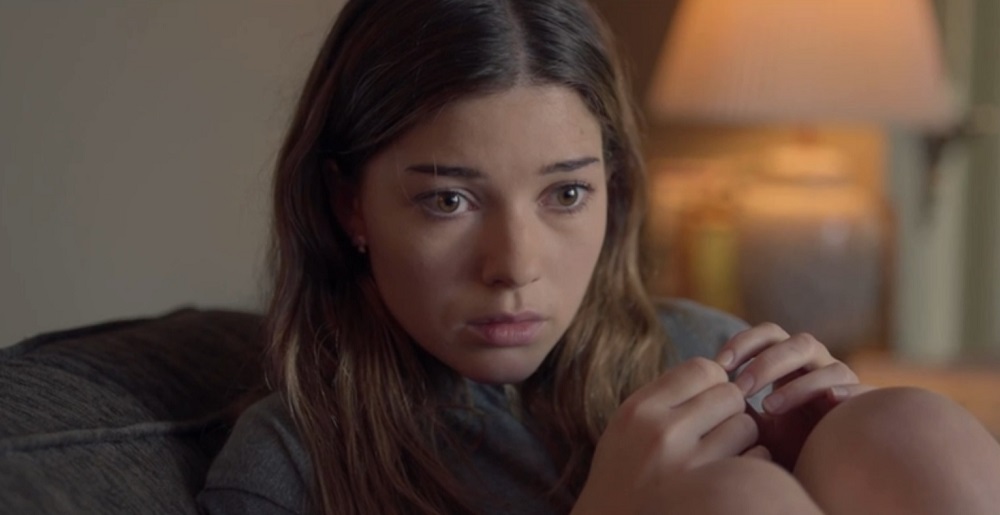Directed by Simone Stock, Lifetime’s ‘The Girl Who Escaped: The Kara Robinson Story’ is a thriller movie that revolves around a young girl and her fight against a criminal. While visiting her best friend, Kara Robinson is kidnapped by a man with a gun. For 18 hours, the abductor keeps her trapped and assaults her in various manners before she can escape. Though it is the middle of the night, the 15-year-old is determined to get her abuser arrested as fast as possible and approaches the police for the same.
Starring Katie Douglas, Cara Buono, Kristian Bruun, and many more, the film paints a chilling story of the horrors inflicted on the young woman. Her determination and drive toward justice keep the audience rooting for her victory. The captivating storyline has already helped the movie garner many fans but has also left many to wonder how the film came to be. Is it inspired by true events or simply a work of fiction? Well, we are here to explore the same and share the answers with you!
The Girl Who Escaped is Based on a Real-Life Kidnapping
Yes, ‘The Girl Who Escaped: The Kara Robinson Story’ is based on a true story. Part of Lifetime’s ‘Ripped from the Headlines’ series, the film is based on the real-life kidnapping of Kara Robinson, a 15-year-old girl from West Columbia, South Carolina. The case in question happened in 2002 and led to the capture of Richard Evonitz, a serial killer responsible for multiple girls’ deaths.

On June 24, 2002, Kara was in the front yard of her best friend’s home when she was approached by a guy in his 30s who claimed to be distributing some pamphlets. “He said, ‘Are your parents home?’ and I said, ‘Well, this isn’t my house. This is my friend’s house,'” Kara shared with People. “And he said, ‘OK, well, what about her parents, are her parents home?’ And I said, ‘No, her mom’s not home right now.'”
After this conversation, the man, who was later identified as Richard Evonitz, apparently pulled out a gun and forced Kara into a large storage bin in his car, a Trans Am. Despite the horrifying situation, the young girl kept track of as many details as possible to increase her chances of survival and escape. From the number of turns made by the vehicle to the music that her kidnapper listened to, Kara had memorized it all. She even learned the serial number of the storage bin she was in by heart.
Before reaching his apartment, Evonitz pulled up his car to restrain and gag Kara. He then took her to his apartment, kept her captive for about 18 hours, and sexually assaulted her. Throughout the ordeal, the teenager kept up with her task of memorizing as many details as possible regarding her surroundings. “We have this survival mechanism within all of us,” she told Fox News. “And I think it’s not anything you could control. But I think my body kicked into that survival mode. For me, I wanted to make sure that I gathered as much information as possible and wait for him to be complacent.”

Kara even tried to manipulate her captor by asking him if she could help him in some manner and ended up sweeping his kitchen. According to the authorities, this might have helped the case as her calm attitude likely put Evonitz at ease. Early next morning, while he slept, the teenager could free one of her hands from the handcuffs and free herself from a leg restraint. Kara then carefully made her way to the apartment’s door and fled her prison. After spotting a car in the parking lot, she quickly rushed towards it and requested the two people inside to take her to the police station.
“It took a while for the relief to kick in,” Kara explained. “Because my captor did run [after my escape]… So it was a slow process. But I really just wanted my life to get back to normal. I didn’t want anybody to treat me differently. The way I dealt with things was to just turn off all of my emotions. I didn’t have an emotional connection to this thing that had happened to me. I just wanted everybody to kind of forget it, too.”
Upon reaching the police station and sharing her story, Kara was asked by the officers to lead them back to the apartment she was held at. Thanks to her observational skills, she could take the authorities to her captor’s house. However, upon arrival, Katie and the police realized that Evonitz had fled. Further investigation revealed a foot-locker within the house containing clippings about the murder of three girls, Sofia Silva, Kati Lisk, and Kristin Lisk. The cases from Spotsylvania County, Virginia, had been unsolved at the time but were quickly linked to Evonitz.
As it turned out, Evonitz had fled to Sarasota, Florida, yet Kara’s testimony and a tip from the kidnapper’s sister led the police to track him down. What followed was a high-speed chase that ended when Evonitz ran over spikes and was attacked by a police dog. Rather than surrendering after being surrounded by law enforcement, he shot himself dead. Due to Evonitz’s link to the three Virginia cases, Kara was awarded $150,000 and a chance to meet with the victims’ families.
The real-life case that serves as the inspiration for ‘The Girl Who Escaped: The Kara Robinson Story’ is a story of horror, determination, and a strong will to survive. Despite the tragedy that befell her, Kara Robinson has remained strong and has consistently advocated any policies and reforms that will help people in a similar situation. In fact, she even participated in an Oxygen and Hulu documentary called ‘Escaping Captivity: The Kara Robinson Story’ to shed light on her story.
Read More: Where Was Lifetime’s The Girl Who Escaped: The Kara Robinson Story Filmed? Who is in the Cast?


You must be logged in to post a comment.